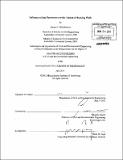Influence of soil parameters on the motion of rocking walls
Author(s)
Houbrechts, Jeroen J. J. (Jeroen Jose Julien)
DownloadFull printable version (10.68Mb)
Other Contributors
Massachusetts Institute of Technology. Dept. of Civil and Environmental Engineering.
Advisor
Eduardo Kausel.
Terms of use
Metadata
Show full item recordAbstract
Introduced as a system in earthquake engineering in 2004 [6], rocking walls are a fairly new system in earthquake engineering. Their performance has been proven, both in research as in practice. However, a few uncertainties about their behavior still remain. One of these uncertainties is the effect of radiation damping on the motion of the system. Existing estimations for the radiation damping use an equivalent damping ratio, which was actually derived for a rocking block that is not connected to any structure. The formula for this equivalent damping ratio also assumes both the block as the soil to be rigid. The validity of the latter can be questioned. This thesis will research the influence of the flexibility of the soil on the motion of a rocking wall. The influence of the shear wave velocity and the Poisson ratio will be considered. The flexible soil medium is modeled with the finite element method, using a 2D plain strain analysis. In order to be able to use a reasonably fine mesh, the dimensions of the soil island will be small. Viscous boundaries are therefore used to absorb incoming waves. The assumption of a rigid rocking wall is considered to be still valid. Therefore, the motion of the rocking wall is modeled by adding only three degrees of freedom to the finite element model of the soil, applying constraint equations and inserting bilinear springs in the interface between the rocking wall and the soil. The dynamic response will be simulated with an implicit, unconditionally stable time domain method. Results show that the motion of the rocking wall strongly depends on the shear wave velocity. The Poisson ratio has a clear but negligible effect. The simulation also shows that it is, as expected, not valid to estimate an equivalent damping ratio for the rocking wall and using this ratio for the system's response.
Description
Thesis (M. Eng.)--Massachusetts Institute of Technology, Dept. of Civil and Environmental Engineering, 2011. Cataloged from PDF version of thesis. Includes bibliographical references (p. 80-81).
Date issued
2011Department
Massachusetts Institute of Technology. Department of Civil and Environmental EngineeringPublisher
Massachusetts Institute of Technology
Keywords
Civil and Environmental Engineering.